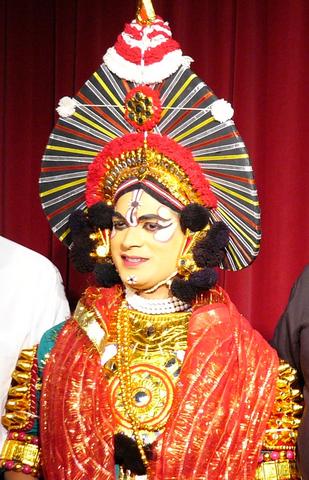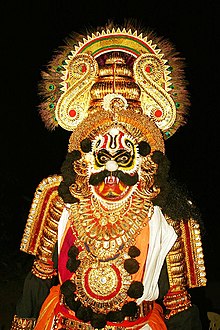| Revision as of 21:35, 7 February 2007 editKNM (talk | contribs)Extended confirmed users, Rollbackers8,336 editsm rm a redundant lead dash← Previous edit | Revision as of 04:39, 9 February 2007 edit undoWiki Raja (talk | contribs)Extended confirmed users14,470 edits ←Reverted revision 106408917 by KNM (talk) via undoNext edit → | ||
| Line 93: | Line 93: | ||
| == See Also == | == See Also == | ||
| {{Template:Dravidian topics}} | |||
| ] | ] | ||
Revision as of 04:39, 9 February 2007

Yakshagana (Kannada:ಯಕ್ಷಗಾನ, Sanskrit:यक्शगन) is a classical folk art form of the state of Karnataka in India mostly popular in the districts of Uttara Kannada, Shimoga,Udupi, Dakshina Kannada and Kasaragod district of Kerala. This would be considered to be a form of opera in western eyes. Actors wear costumes and enact the various roles. Traditionally, Yakshaganas would go on all night. It is sometimes simply called as Aataā in both Kannada and Tulu (meaning play).
A Yakshagana performance begins at the twilight hours with the beating of drums for up to a couple of hours before the 'actors' get on the stage. The actors wear resplendent costumes, head-dresses, and painted faces which they paint themselves. A performance usually depicts a story from the Hindu epics and puranas. It consists of a narrator who narrates the story in a song-like fashion, backed by musicians playing on traditional musical instruments as the actors dance to the tune, with actions that portray the story as it is being narrated. The actors have a limited dialog during the course of the performance.
The Word and the World
Yakshagana is a traditional theater form combining dance, music, spoken word, costume-makeup, and stage technique with a distinct style and form. ≠ Both the word Yakshagana and its world are interesting and intriguing. It is a theater form mainly prevalent in the coastal districts and adjacent areas, in Karnataka. It is closely connected with other forms prevailing in other parts of Karnataka, and its neighboring states of Andhra Pradesh, Kerala, Tamilnadu and Maharastra.
Yakshagana, like many other forms, defies neat classification into categories like folk, classical, rural. It can be included into each of these, or all of them together, depending upon our line of approach. Being a theater form, unlike a dance form, it is more plural and dynamic. And hence it exhibits many types and varieties inside itself. However, Yakshagana can be rightly called a traditional form. Primarily it is a name given to the one prevailing in Coastal and Malnad areas of Karnataka, though in fringe forms like Doddata are also called by the same name often, especially recently . The traditional theater form Mudalpaya of Southern Karnataka, the Doddata of Northern Karnataka, the Kelike in the borders of Andhra Pradesh, the Ghattadakore of Kollegal in Chamarajnagar district – are such forms . Among them, the Ghattadakore is a direct branch of Coastal Yakshagana, while Mudalapaya is the most closely connected form. There is a form called Yakshaganamu in Andhra Pradesh also which exhibits resemblance to the forms of Karnataka plateau region.
Thre are scholars who have studied Yakshagana as a subject and even got doctorate degree. Mr.Prabhakar M Joshi is one amongst them.
The Genesis
The origin of any art form is in a way difficult to fix and the time and process of formation conceived is often arbitrary. As art forms grow over a period, and they include various elements from time to time and undergo many changes until they appear as we see them today. Theater forms become solo performances (for example, Kathak) and may be vice versa.
The Origin
Basically Yakshagana is the product of the Vaishnava Bhakthi movement. Vaishnavism as a school of thought and religion is quite old. The Bhakthi movement proper, spread with vigor after the 10th Century. It took religion to the common man, to the lower strata of society, those classes to whom the highly formalized and Vedic religion was beyond reach. Hence Bhakthi movement was a social movement also.

In order to propagate and spread the message of devotion, it adopted and adapted the existing folk as well as classical literary forms and performances. It created its own forms. Most of the traditional theater forms are the result of this phenomenon. Hence there are clear resemblance among the members of the 'Traditional Theater Family' like Ankhia Nata (Assam), Jathra (Bengal), Chau (Bihar, Bengal), Prahlada Nata (Orissa), Veedhinatakam & Chindu (Andhra), Terukoothu Bhagawathamela (Tamil Nadu), Kathakkali (Kerala). Yet there are major differences also. Yakshagana is a member of this group and so its origin is connected with a wider historical situation.
Experts have placed the origin of Yakshagana from the 11th Century to the 16th Century. Earliest limit is fixed by a finding by Vidwan Bannanje Govindacharya who says a legend goes to show that Sage Narahari Thirtha (c, 1300) started a Dasavathara Ata performance and a troupe in Udupi and later this spread to other places and grew into what we call Yakshagana today.
Anyway, Yakshagana must have been an established form by the time of famous Yakshagana poet Parthisubba (1600) who wrote the Ramayana in Yakshagana. Because he is said to be a Bhagawatha (singer) himself and is believed to have founded a troupe, and probably he is the formulator of the Tenkuthittu (Southern style) of the art. Troupe centers like Koodlu and Kumbla in Kasaragod District, and Amritheshwari, Kota near Kundapur claim having a troupe three to four centuries ago. So we can safely assume that this art form had taken shape by about 1500. However, what we see today as Yakshagana, must have been the result of a slow evolution, drawing its elements from ritual theater, temple arts, secular arts like Bahurupi, royal courts of the time and artists imaginations – all interwoven over period.
Growth and Changes
With the socio-economic changes of the 19th Century, arts like Yakshagana also changed. The 19th Century produced a big number of compositions. Around 1800, a troupe from Dharmastala visited the court of the king of Mysore and established a troupe there. In the 1840s, a troupe from Uttara Kannada (North Kanara) visited Maharastra, and inspired the first modern age mythological drama by Vishudas Bhave. A number of troupes arose all over the Coastal Karnataka and probably in other parts of Karnataka too. By the early decades of this Century the structure of Yakshagana reached a definite shape and form.

1930s saw some changes in compositions, organizations and presentation. Dance and the spoken word was further developed and refined. But in costume, a type of degeneration started setting in due to the use of 'modern' clothing and stone jewelery, in place of hand loom clothing and wooden ornaments.
The Year 1950 saw the birth of 'tent' troupes, giving performances to audience by tickets, with 'tent theaters' and furniture for seating. These troupes brought in commercialization of Yakshagana, with both merits and demerits. Yakshagana saw major changes in form and organisation, electrical lights replaced the 'gas lights' or 'petromax' lamps. Seating arrangements improved. Major changes came in the themes, with the inclusion of folk epics, Sanskrit dramas and created (imaginary) stories forming the thematic base. Popular entertainment became the criterion in place of 'classical' presentation. Tulu, the language of the Southern part of the D.K. district was introduced on the stage, where hitherto only Kannada was used. This gained great popularity. All these trends continued with added vigor after 1970s, with a new element of influence. Noted writer, Late Dr. Kota Shivaram Karanth experimented with the dance form by introducing Western musical instruments. He also reduced the time of a Yakshagana performance from 12 hours to two and half hours, for the convenience of city dwellers. Another trend that has emerged in modern Yakshagana is the incorporation of movie stories. The best example is the prasanga titled "Nagavalli" which has been inspired by the Kannada movie, "Aaptamitra." Though it has been derided the purists, these prasanga are quite popular among people.
The North Kanara style of Yakshagana hitherto not know outside, started making a big impact on other styles. This trend continues even today.
Along with all these, the traditional type of troupes, giving free shows financed by devotees still continue and have a very good support.
The Variations
There are basically two variants of Yakshagana.
Badagutittū

The Badagutittū style is prevalent in Northern parts of Tulu Nadu, that is, from Padubidri to Byndoor.
Tenkutittū
The second variation, the Tenkutittū style, is prevalent in Southern areas of Tulu Nadu, that is, from Mulki to Kasargod.
The Troupes
Yakshagana is one of the most living art traditions in the World. There are about 30 full fledged professional troupes, and about 200 amateur troupes in Yakshagana. Professional troupes go on tour between November to May, giving about 180-200 shows that is, a full night show everyday!
There are about one thousand professional artists and much bigger number of amateurs. Further there are off season shows during the wet season, the anniversary shows, school and college students Yakshagana and of course the Talamaddale performances. All put together, we safely say that Karnataka witnesses about 12,000 Yakshagana performances every year!
Yakshagana has not so far shown signs of quantity decline, in spite of very fast 'modernization' and 'urbanization'.
Yakshagana Puppetry
Another interesting facet of Yakshagana is the its use in puppetry. Evidence shows that there were more than 30 string puppet troupes in the undivided Dakshina Kannada district during the period 1910 – 1915 in places like Basrur, Barkur, Kokkarne, Mudabidri etc.
The puppetry in Yakshagana style is interesting as the presentation is highly stylized and adheres strictly to the norms and standards of Yakshagana. The puppets used are generally 18 inches high and the costumes are similar to those worn by the characters from Yakshagana with the same elaborate make-up, colorful head gear and heavy jewelery. The person who infuses life into the puppet and makes it come alive, by dexterous manipulation is known as the Suthradhara. The content in the Yakshagana puppetry, is drawn heavily from the ancient epics.
Background of Yakshagana Puppetry
Though Yakshagana puppetry had existed since a long time, it was moulded by Laxman, Narasimha and Manjappa Kamath, hailing from Uppinakudru village in Kundapur taluk. Devanna Padmanabha Kamath, the grand son of Laxman Kamath infused new life into it and performed shows all over India. Currently, his son Kogga Kamath is at the forefront, performing shows and training youngsters in Yakshagana puppetry.
Training and Research
Training schools for Yaskhagana are very few in Coastal Karnataka. As most troupes are associated with temples, the training has been confined to the temple premises. However, the Govinda Pai Research Institute, located at MGM College, Udupi, runs a Yakshagana Kalakendra in Udupi that trains youngsters in this ancient dance form. The Govinda Pai Research Institute does research work on language, rituals and dance art forms of Tulu Nadu.
External links
- Videos of Puppet Yakshagana
- Celebration of Celestials
- Yakshagana Site-1
- Yakshagana Site-2
- Yakshagana Site-3
- Portion of Karthaveeryarjuna Yakshagana
- http://www.yakshaganapuppets.com/
- http://kondadakuli.tripod.com/
- http://www.yaksharanga.org/
- http://www.flickr.com/photos/yakshagana/